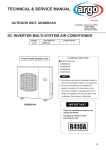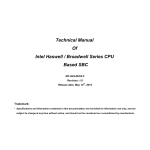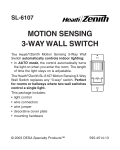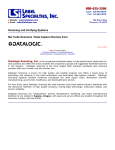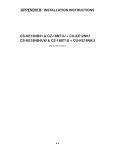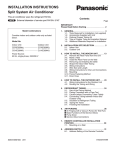Download Argo AE3MI70AH Installation manual
Transcript
INSTALLATION INSTRUCTIONS - Split system air conditioner COOL / DRY/ HEAT Model This air conditioner uses the new refrigerant R410A. Contents Model Combinations Page IMPORTANT! Please Read Before Starting .................................. 1 1. GENERAL .......................................................... 2 1-1. Tools Required for Installation (not supplied) 1-2. Accessories Supplied with Unit 1-3. Optional Copper Tubing Kit 1-4. Type of Copper Tube and Insulation Material 1-5. Additional Materials Required for Installation 2. INSTALLATION SITE SELECTION ................... 3 2-1. Indoor Unit 2-2. Embedding the Tubing and Wiring 3. HOW TO INSTALL THE INDOOR UNIT ............ 9 3-1. Remove the Rear Panel from the Unit 3-2. Make a Hole 3-3. Install the Rear Panel on the Wall 3-4. Remove the Grille to Install the Indoor Unit 3-5. Shape the Indoor Side Tubing 3-6. Wiring Instructions 3-7. Wiring Instructions for Inter-unit Connections 3-8. Mounting 3-9. Drain Hose 4. HOW TO SECURE THE WIRELESS REMOTE CONTROL UNIT................................................ 18 4-1. Mounting on a Wall 5. ADDRESS SETTING OF THE REMOTE CONTROL UNIT................................................ 19 5-1. Setting the Remote Controller Address 5-2. Operating Multiple Indoor Units with a Single Remote Controller 6. TEST RUN......................................................... 20 7. INSTALLATION CHECK SHEET ...................... 20 85264189902000 02/2004 Combine indoor and outdoor units only as listed below. Indoor Unit Outdoor Unit AWMI28AHL AE2MI56AH AWMI36AHL AE3MI70AH AWMI50AHL AE4MI91AH AWMI70AHL Power Source: 50 Hz, single-phase, 220 – 240 V / 60 Hz, single-phase 220 V Combinations of indoor and outdoor units Connect indoor and outdoor units only in the combinations listed in the catalog or installation manual. CAUTION Connecting any other model may result in operation failure and system damage. IMPORTANT! Please Read Before Starting When Installing… This air conditioning system meets strict safety and operating standards. As the installer or service person, it is an important part of your job to install or service the system so it operates safely and efficiently. …In a Ceiling or Wall Make sure the ceiling/wall is strong enough to hold the unit’s weight. It may be necessary to construct a strong wood or metal frame to provide added support. For safe installation and trouble-free operation, you must: ● Carefully read this instruction booklet before beginning. ● Follow each installation or repair step exactly as shown. ● Observe all local, state, and national electrical codes. ● Pay close attention to all warning and caution notices given in this manual. This symbol refers to a hazard or unsafe practice which can WARNING result in severe personal injury or death. This symbol refers to a hazard or unsafe practice which can CAUTION result in personal injury or product or property damage. …In a Room Properly insulate any tubing run inside a room to prevent “sweating” that can cause dripping and water damage to walls and floors. When Connecting Refrigerant Tubing • Do not add any refrigerant, air, or substance into the refrigeration circuit other than the designated refrigerant (R410A). Adding anything other than the specified refrigerant may cause the pressure to rise excessively in the refrigeration circuit, rupturing the circuit and causing injury or damage. • Use all-new tubing and flare nuts to make the tubing connections. Using any previous parts (from R22based systems) may result in damage to the equipment, and may lead to the refrigeration circuit rupturing, causing a serious accident. If Necessary, Get Help These instructions are all you need for most installation sites and maintenance conditions. If you require help for a special problem, contact our sales/service outlet or your certified dealer for additional instructions. • Apply refrigerant lubricant to the matching surfaces of the flare and union tubes before connecting them, then tighten the nut with a torque wrench for a leakfree connection. In Case of Improper Installation The manufacturer shall in no way be responsible for improper installation or maintenance service, including failure to follow the instructions in this document. • Check carefully for leaks before starting the test run. When Servicing SPECIAL PRECAUTIONS WARNING • Turn the power OFF at the main power box (mains) before opening the unit to check or repair electrical parts and wiring. When Wiring • Keep your fingers and clothing away from any moving parts. ELECTRICAL SHOCK CAN CAUSE SEVERE PERSONAL INJURY OR DEATH. ONLY A QUALIFIED, EXPERIENCED ELECTRICIAN SHOULD ATTEMPT TO WIRE THIS SYSTEM. • Clean up the site after you finish, remembering to check that no metal scraps or bits of wiring have been left inside the unit being serviced. • Do not supply power to the unit until all wiring and tubing are completed or reconnected and checked. Others • Highly dangerous electrical voltages are used in this system. Carefully refer to the wiring diagram and these instructions when wiring. Improper connections and inadequate grounding can cause accidental injury or death. CAUTION • Ventilate any enclosed areas when installing or testing the refrigeration system. Escaped refrigerant gas, on contact with fire or heat, can produce dangerously toxic gas. • Ground the unit following local electrical codes. • Connect all wiring tightly. Loose wiring may cause overheating at connection points and a possible fire hazard. • Confirm upon completing installation that no refrigerant gas is leaking. If escaped gas comes in contact with a stove, gas water heater, electric room heater or other heat source, it can produce dangerously toxic gas. When Transporting Be careful when picking up and moving the indoor and outdoor units. Get a partner to help, and bend your knees when lifting to reduce strain on your back. Sharp edges or thin aluminum fins on the air conditioner can cut your fingers. 1 1. General 6. 7. 8. 9. 10. 11. 12. 13. 14. 15. This booklet briefly outlines where and how to install the air conditioning system. Please read over the entire set of instructions for the indoor and outdoor units and make sure all accessory parts listed are with the system before beginning. 1-1. Tools Required for Installation (not supplied) 1. Standard screwdriver 2. Phillips head screwdriver 3. Knife or wire stripper 4. Tape measure 5. Carpenter’s level Sabre saw or key hole saw Hacksaw Core bits Hammer Drill Tube cutter Tube flaring tool Torque wrench Adjustable wrench Reamer (for deburring) 1-2. Accessories Supplied with Unit Table 1 Q’ty Parts Remote control unit 1 Remote control holder AAA alkaline battery 2 Parts Figure Tapping screw Figure Trusshead screw Q’ty Parts 1 Tapping screw 3. Copper tubing for connecting the outdoor unit to the indoor unit is available in kits which contain the narrow and wide tubing, fittings and insulation. Consult your nearest sales outlet or A/C workshop. CAUTION If you wish to purchase these materials separately from a local source, you will need: Deoxidized annealed copper tube for refrigerant tubing as detailed in Table 2. Cut each tube to the appropriate lengths +30 cm to 40 cm to dampen vibration between units. Table 2 Narrow Tube Model Wide Tube Outer Dia. Thickness Outer Dia. Thickness AWMI28AHL 6.35 mm 0.8 mm 9.52 mm 0.8 mm AWMI36AHL 6.35 mm 0.8 mm 9.52 mm 0.8 mm AWMI50AHL 6.35 mm 0.8 mm 9.52 mm 0.8 mm AWMI70AHL 6.35 mm 0.8 mm 12.7 mm 0.8 mm 2. Foamed polyethylene insulation for the specified copper tubes as required to precise length of tubing. Wall thickness of the insulation should be not less than 8 mm. 2 4 × 30 mm 8 Use insulated copper wire for field wiring. Wire size varies with the total length of wiring. Refer to 3-6. Wiring Instructions for details. 1-4. Type of Copper Tube and Insulation Material 1. Trusshead screw Q’ty 2 4 × 16 mm 1-3. Optional Copper Tubing Kit Figure Check local electrical codes and regulations before obtaining wire. Also, check any specified instructions or limitations. 1-5. Additional Materials Required for Installation 1. 2. Refrigeration (armored) tape Insulated staples or clamps for connecting wire (See local codes) Putty Refrigeration lubricant Clamps or saddles to secure refrigerant tubing 3. 4. 5. 2. Installation Site Selection 2-1. Indoor Unit WARNING To prevent abnormal heat generation and the possibility of fire, do not place obstacles, enclosures, and grilles in front of or surrounding the air conditioner in a way that may block air flow. AVOID: ● direct sunlight. ● nearby heat sources that may affect performance of the unit. ● areas where leakage of flammable gas may be expected. ● placing or allowing any obstructions near the A/C inlet or outlet. ● installing in rooms that contain instant-on (rapidstart) fluorescent lamps. (These may prevent the A/C from receiving signals.) ● places where large amounts of oil mist exist. ● installing in locations where there are devices that generate high-frequency emissions. Indoor unit Drain hose DO: ● select an appropriate position from which every corner of the room can be uniformly cooled. (High on a wall is best.) ● select a location that will hold the weight of the unit. ● select a location where tubing and drain hose have the shortest run to the outside. (Fig. 1) ● allow room for operation and maintenance as well as unrestricted air flow around the unit. (Fig. 2) ● install the inter-unit cable more than 1 meter away from any antenna or power lines or connecting wires used for television, radio, telephone, security system, or intercom. Electrical noise from any of these sources may affect operation. Outside drainage Fig. 1 15 cm min. 15 cm min. Front View Fig. 2 3 15 cm min. ● ● install in a sturdy manner to avoid increased operating noise. Tubing length (L1) INDOOR UNIT (1) install the unit within the maximum elevation difference (H1, H2, H3, H4) above or below the outdoor unit and within a total tubing length (L1+L2, L1+L2+L3, L1+L2+L3+L4) from the outdoor unit as detailed in Table 3 and Fig. 3a. INDOOR UNIT (2) Elevation difference (H1) L2 OUTDOOR UNIT H2 L3 H4 INDOOR UNIT (4) INDOOR UNIT (3) L4 H3 Fig. 3a Table 3 Model (Outdoor unit) Max. Allowable Tubing Length per unit (m) Limit of Total Tubing Length (L1+L2), (L1+L2+L3) or (L1+L2+L3+L4) (m) Limit of Elevation Difference (H) (m) AE2MI56AH 25 35 (L1+L2) 10 AE3MI70AH 25 50 (L1+L2+L3) 10 AE4MI91AH 30 70 (L1+L2+L3+L4) 10 CAUTION Indoor unit For stable operation of the air conditioner, do not install wall-mounted type indoor units less than 1.5 m from floor level. Minimum height from floor level 1.5 m Floor level Fig. 3b 4 Wall AE2MI56AH (1) Connecting indoor unit types (28 – 36) at B Outdoor unit Indoor unit φ6.35 (28 36 type) A φ9.52 φ6.35 (28 36 type) B φ9.52 Fig. 2a (2) Connecting indoor unit type 50 at B (Length of tube: more than 17 m) Outdoor unit Indoor unit φ6.35 (28 36 types) A φ9.52 φ9.52 φ6.35 (50 type) B φ12.7 φ9.52 Flare φ9.52 Union φ12.7 (More than 17 m) Union φ12.7 Flare φ9.52 A joint for connecting tubes of different sizes Fig. 2b (3) Connecting indoor unit type 50 at B (Length of tube: less than 17 m) Outdoor unit φ6.35 (28 36 types) A φ9.52 φ9.52 φ6.35 (50 type) B φ9.52 Indoor unit φ9.52 (Less than 17 m) Fig. 2c 5 AE3MI70AH (1) Connecting indoor unit types (28 – 36) at C Outdoor unit Indoor unit φ6.35 (28 36 type) A φ9.52 φ9.52 φ6.35 (28 36 type) B φ9.52 φ9.52 φ6.35 (28 36 type) C φ9.52 φ9.52 Fig. 2d (2) Connecting indoor unit type 50 at C (Length of tube: more than 17 m) Indoor unit Outdoor unit φ6.35 (28 36 types) A φ6.35 φ9.52 φ9.52 (28 36 types) B φ9.52 φ9.52 φ6.35 (50 type) C φ12.7 φ9.52 Flare φ9.52 Union φ12.7 (More than 17 m) Union φ12.7 Flare φ9.52 A joint for connecting tubes of different sizes Fig. 2e (3) Connecting indoor unit type 50 at C (Length of tube: less than 17 m) Outdoor unit Indoor unit φ6.35 A (28 36 types) φ9.52 φ9.52 B φ9.52 (28 36 types) φ9.52 φ6.35 C φ9.52 φ6.35 (50 type) φ9.52 (Less than 17 m) Fig. 2f Note: It is not possible to connect the indoor unit type 70 to 2 or 3 room outdoor unit. 6 AE4MI91AH (1) Connecting indoor unit types 28 to 36 at D Outdoor unit Indoor unit φ6.35 A (28 36 types) φ9.52 φ9.52 φ6.35 φ6.35 φ9.52 (28 36 types) B φ9.52 (28 36 types) C φ9.52 φ9.52 φ6.35 (28 36 types) D φ12.7 φ9.52 Flare φ12.7 Union φ9.52 Fig. 2a (φ12.7 → φ9.52) Supplied Reducer (2) Connecting indoor unit type 50 at D (Length of tube: more than 17 m) Outdoor unit Indoor unit φ6.35 (28 36 types) A φ9.52 φ9.52 φ6.35 (28 36 types) B φ9.52 φ9.52 φ6.35 (28 36 types) C φ9.52 φ9.52 φ6.35 (50 type) D φ12.7 φ12.7 (More than 17 m) Fig. 2b Union φ12.7 Flare φ9.52 (3) Connecting indoor unit type 50 at D (Length of tube: less than 17 m) Outdoor unit Indoor unit φ6.35 (28 36 types) A φ9.52 φ9.52 φ6.35 (28 36 types) B φ9.52 φ9.52 φ6.35 (28 36 types) C φ9.52 φ9.52 φ6.35 (50 type) D φ12.7 φ9.52 Flare φ12.7 Fig. 2c Union φ9.52 (φ12.7 → φ9.52) Supplied Reducer (4) Connecting indoor unit type 70 at D Outdoor unit (28 36 types) A φ9.52 φ9.52 Fig. 2d D φ12.7 φ6.35 (28 36 types) B φ9.52 C φ9.52 Indoor unit φ6.35 φ6.35 φ9.52 (28 36 types) φ9.52 φ6.35 (70 type) φ12.7 7 2-2. Embedding the Tubing and Wiring ● Before beginning embedding installation work, consult fully with agencies or offices related to the building’s foundation, construction, electricity, and water. ● Wait to make connections to the embedded portion. Each connection step is described later in this manual. ● Securely cover the end of the embedded tubing to prevent intrusion of dirt or moisture. ● If an embedded tube is to be left for a long time, fill the tube with nitrogen and seal both ends securely. If a tube is left open for an extended time, moisture in the air inside the tubing may condense into water droplets, and lead to water contamination of the refrigerant circuit. ● In order to prevent insulation breakdown and ground faults, do not allow wiring ends to come in contact with rainwater, or be subjected to condensation or dew. ● Apply sufficient thermal insulation to the refrigerant tubing and drain pipes. 8 3. How to Install the Indoor Unit (AWMI28AHL) 3-1. Remove the Rear Panel from the Unit (AWMI28AHL) (1) Remove and discard the set screw on the rear panel. (Fig. 5a) (2) Press the 2 ▲ marks on the frame cover and disengage the stationary tabs from the frame. (Fig. 6a) Set screw only for transportation (3) Remove the rear panel. Fig. 5a (AWMI36/50AHL) (AWMI36/50AHL) First, remove the rear panel from the indoor unit. Remove the screws attaching the panel and push up the attachment tabs to permit a slight space, then completely remove the panel. (The removed screws are no longer needed.) Rear panel Screw Attachment tab NOTE Fig. 5b Tubing can be extended in 5 directions as shown in Fig. 6a. Select the direction you need providing the shortest run to the outside unit. ● (AWMI28AHL) Rear panel When left tubing is to be done, switch the drain hose and drain cap. (For details, refer to “Switching drain hose and drain cap” on page 13.) 3-2. Make a Hole (1) Place the rear panel from the indoor unit on the wall at the location selected. Make sure the panel is horizontal, using a carpenter’s level or tape measure to measure down from the ceiling. Wait until after cutting the hole before attaching the rear panel to the wall. ▲ marks Fig. 6a (2) Determine which side of the unit you should make the hole for tubing and wiring. (Figs. 7a & b) Right-rear tubing (recommended) Left tubing NOTE In the case of left-rear tubing, use the outside ▼ mark for precise placement of the hose outlet. (Figs. 7a & b) Left-rear tubing Right tubing (3) Before making the hole, check carefully that no studs or pipes are directly run behind the spot to be cut. Downward tubing Fig. 6b CAUTION Also avoid areas where electrical wiring or conduits are located. In case of left-rear, right-rear tubing (AWMI28AHL) The above precautions are also applicable if tubing goes through the wall in any other location. Fig. 7a 9 (4) Using a sabre saw, key hole saw or hole-cutting drill attachment, cut a hole in the wall. See Table 4 and Fig. 8. (AWMI36/50AHL) Bending point Bending point Table 4 Hole Dia. (mm) AWMI28/36/50AHL AWMI70AHL 65 80 Center of left-rear tubing hole Center of right-rear tubing hole Fig. 7b (5) Measure the thickness of the wall from the inside edge to the outside edge and cut PVC pipe at a slight angle 6 mm shorter than the thickness of the wall. (Fig. 9) In case of left-rear or right-rear tubing (AWMI70AHL) (6) Place the plastic cover over the end of the pipe (for indoor side only) and insert the pipe in the wall. (Fig. 10) NOTE Hole should be made at a slight downward slant to the outdoor side. Center of left-rear tubing hole 3-3. Install the Rear Panel on the Wall Be sure to confirm that the wall is strong enough to suspend the unit. See either Item a) or b) below depending on the wall type. Center of right-rear tubing hole Fig. 7c Indoor side a) If Wooden Wall Outdoor side PVC pipe (locally purchased) (1) Attach the rear panel to the wall with the 6 screws provided. (Fig. 11a) If you are not able to line up the holes in the rear panel with the beam locations marked on the wall, use rawl plugs or toggle bolts to go through the holes on the panel or drill 5 mm dia. holes in the panel over the stud locations and then mount the rear panel. Fig. 8 Cut at slight angle Fig. 9 INSIDE When you attach the rear panel to the wall you must use the top installation screw holes. Install the panel levelly, confirming with a carpenter’s level. (Alternately, you can check for levelness by hanging a weighted string from the center hole of the panel, making sure the string lines up with the triangle mark at the bottom of the panel.) OUTSIDE Wall Plastic cover PVC pipe Slight angle Plastic cover Fig. 10 (AWMI36/50AHL) (AWMI36/50AHL) 805 Open the extension boards as marked and check the dimensions. Use the supplied 8 installation screws. (Fig.11b) 27.5 19.5 40 Hole for temporary attachment 285 Hole for tubing (φ65 ) Fig. 11a Fig. 11b 10 41 309 344 99 99 Extension board 41 (AWMI28AHL) 450 27.5 (2) Double check with a ruler or carpenter’s level that the panel is level. This is important to install the unit properly. (Fig. 12) (3) Make sure the panel is flush against the wall. Any space between the wall and unit will cause noise and vibration. Fig. 12 b) If Block, Brick, Concrete or Similar Type Wall Make 4.8 mm dia. holes in the wall. Insert rawl plugs for appropriate mounting screws. (Fig. 13) 4.8 mm dia. hole Rawl plug (Field supply) 3-4. Remove the Grille to Install the Indoor Unit Basically, these models can be installed and wired without removing the grille. If access to any internal part is needed, follow the steps as given below: Fig. 13 How to remove the grille (AWMI28/36/50AHL) (1) Set the flap in the horizontal position. (2) Unscrew the 2 screws. (Fig. 14a) (3) Remove the grille. (Fig. 14b) (a) Hold both corners of the air intake grille, then pull out and up to open. (b) Pull the lower part of the grille toward you to remove. Screw cover Flap (Up and down air direction louvre) (c) Use a standard screwdriver to push up the 2 tabs to remove the grille. Fig. 14a How to remove the grille (AWMI70AHL) Air intake grille (1) Set the 2 flaps in the horizontal position. (2) Unscrew the 3 screws. (Fig. 14c) (3) Remove the grille. (a) Hold both corners of the air intake grille, then pull out and up to open. (Fig. 14d) (b) Use a standard screwdriver to push up the 3 tabs to remove the grille. (Fig. 14d) (c) Pull the lower part of the grille toward you to remove. (Fig. 14c) Fig. 14b Air intake grille Grille Air intake grille Fig. 14c Fig. 14d 11 How to replace the grille (1) Close the flaps. (2) Reinstall the grille into the lower part while aligning its tabs on the upper part. (Fig. 15a) Insert the tabs in the slots and push the lower part of the grille back into position. Fig. 15a (3) Press at each of the 4 tabs to completely close the grille. Make sure that the grille and frame are firmly fitted together. (Fig. 15b) 3-5. Shape the Indoor Side Tubing 1) Arrangement of tubing by directions Fig. 15b a) Right or left tubing Cut out the corner of the right/left frame with a hacksaw or the like. (Figs. 16 and 17) Frame b) Right-rear or left-rear tubing In this case, the corner of the frame need not be cut. Left tubing outlet 2) To mount the indoor unit on the rear panel: Hang the 2 mounting slots of the unit on the upper tabs of the rear panel. (Fig. 18) Fig. 16 3-6. Wiring Instructions General precautions on wiring 1) 2) Before wiring, confirm the rated voltage of the unit as shown on its nameplate, then carry out the wiring closely following the wiring diagram. Right tubing outlet Provide a power outlet to be used exclusively for each unit, with a power supply disconnect and circuit breaker for overcurrent protection provided in the exclusive line. 3) To prevent possible hazard due to insulation failure, the unit must be grounded. 4) Each wiring connection must be done tightly and in accordance with the wiring system diagram. Wrong wiring may cause the unit to misoperate or become damaged. 5) Do not allow wiring to touch the refrigerant tubing, compressor, or any moving parts of the fan. 6) Frame Fig. 17 (AWMI28/36/50AHL) Fig. 18 (AWMI70AHL) Unauthorized changes in the internal wiring can be very dangerous. The manufacturer will accept no responsibility for any damage or misoperation that occurs as a result of such unauthorized changes. Mounting slot Fig. 19 12 Tab 3-7. Wiring Instructions for Inter-unit Connections (1) Hold both corners of the air intake grille, then pull out and up to open. (2) Remove the screw on the right side cover plate and open the cover. (Fig. 20) (3) Insert the inter-unit wiring into the through-the-wall PVC pipe. Lead the wiring into the room allowing approx. 30 cm for right side and 120 cm for left side tubings to extend from the wall face. (Fig. 21a) Fig. 20 (4) Route the inter-unit wiring from the back of the indoor unit and pull it toward the front for connection. (Fig. 21b) (5) Connect the inter-unit wiring to the corresponding terminals on the terminal plate (Fig. 21b) while referring to the wiring diagram. Plastic cover Rear panel (6) Be sure to secure the wiring with the provided clamp. Plastic cover NOTE Wiring When closing the air intake grille, press on both corners and the center. (Fig. 21c) 120 cm 25 cm Fig. 21a Fig. 21b Fig. 21c 13 WARNING Loose wiring may cause the terminal to overheat or result in unit malfunction. A fire hazard may also exist. Therefore, be sure all wiring is tightly connected. 7 mm (ACTUAL SIZE) STRIP SIZE Fig. 22 Strip 25 mm When connecting each power wire to the corresponding terminal, follow the instructions “How to connect wiring to the terminal” and fasten the wire securely tight with the fixing screw of the terminal plate. Solid wire Loop How to connect wiring to the terminal Insulation a) For Indoor Unit Fig. 23a (1) Cut the wire end with a cutting pliers, then strip the insulation to expose the wire about 7 mm. See the label (Fig. 22) near the terminal plate. Strip 10 mm Stranded wire (2) Using a screwdriver, loosen the terminal screw on the terminal plate. (3) Insert the wire and tighten the terminal screw completely using a screwdriver. Ring connector Fig. 23b b) For Outdoor Unit Twist wire ends ■ For solid core wiring (or F-cable) (1) Cut the wire end with a cutting pliers, then strip the insulation to expose the solid wire about 25 mm. (Fig. 23a) (2) Using a screwdriver, remove the terminal screw(s) on the terminal plate. Fig. 23c (3) Using the pliers, bend the solid wire to form a loop suitable for the terminal screw. Special washer (4) Shape the loop wire properly, place it on the terminal plate and fix it securely with the removed terminal screw using a screwdriver. Screw Ring connector Wire Terminal plate ■ For stranded wiring (1) Cut the wire end with a cutting pliers, then strip the insulation to expose the stranded wiring about 10 mm and tightly twist the wire ends. (Figs. 23b and 23c) Wire Fig. 23d (2) Using a screwdriver, remove the terminal screw(s) on the terminal plate. (3) Using a ring connector fastener or pliers, securely clamp each stripped wire end with a ring connector. (Fig. 23b) (4) Place the ring connector wire, and replace and tighten the removed terminal screw using a screwdriver. (Fig. 23d) 14 Screw and special washer Ring connector 3-8. Mounting (1) To install the indoor unit, mount the indoor unit onto the tabs on the upper part of the rear plate. (2) Hold down the air discharge outlet and press the lower part of the indoor unit until it clicks to securely fasten to the 2 tabs on the lower part of the rear plate. (Fig. 24a) NOTE Push For tubing, choose either the right or left tubing direction and follow the steps below. Also, extend the support on the back of the indoor unit as a stand to make your work easier. (Fig. 24b) Fig. 24a ■ Right-side tubing (1) Shape the refrigerant tubing so that it can easily go into the wall hole. Wrap the tubing with duct tape or the equivalent, together with the drain hose and inter-unit cable (if permitted by local codes). Position the drain hose below the pipe. Be sure there is enough extra slack to prevent any strong pulling forces on the drain hose. (Fig. 25) Stand Fig. 24b (2) Push the wiring, refrigerant tubing, and drain hose through the hole in the wall. Adjust the indoor unit so it is securely seated on the rear panel. (Fig. 26) Rear panel Cover Refrigerant tubing (3) Carefully bend the tubing (if necessary) to run along the wall in the direction of the outdoor unit and then tape as far as the fittings. The drain hose should come straight down the wall to a point where water runoff won’t stain the wall. Inter-unit wiring Drain hose Fig. 25 Fig. 26 15 ■ Left-side tubing (1) Lead the tubing and drain hose through the wall, allowing sufficient length for connection. Then bend the tubing using a tube bender to make the attachment. (Fig. 27a) Rear panel Hole in wall (2) Switch the drain hose and drain cap. Wide tube Bent part Narrow tube Switching drain hose and drain cap Fig. 27a (a) Locate the drain hose and drain cap. (Fig. 27b) (b) Remove the drain hose on the right side by pushing and turning the hose connector counter-clockwise to release it. (Fig. 27b) (c) Apply moderate force to pull off the drain cap on the left side. (If you cannot pull it off by hand, use a long-nose pliers.) Drain cap Drain hose (d) Reattach the drain hose to the left side and the drain cap to the right side. (Fig. 27c) Fig. 27b Drain hose While pushing the drain connector, turn it clockwise until it clicks. Slip the connector onto the outlet firmly. Drain hose Drain cap Use a Phillips screwdriver to push the drain cap in firmly. (If it is difficult to push in, wet the cap with water first.) Clamp To slip on 60° Drain cap (3) Install the indoor unit on the rear panel. (4) Connect the tubing and wiring led inside from outdoors. (5) After completing a leak test, bundle the tubing together with armoring tape and store it inside the tubing storage area at the back of the indoor unit and hold it with clamps. Fig. 27c Refrigerant tubing Inter-unit wiring Drain hose Fig. 28 16 To remove To unmount indoor unit Press the 2 ▲ marks on the lower part of the indoor unit and unlatch the tabs. Then lift the indoor unit and unmount. (Fig. 29) 3-9. Drain Hose b) Never form a trap in the course of the hose. c) If the drain hose will run in the room, insulate the hose with insulation* so that chilled condensation will not damage furniture or floors. (Fig. 31) Push Fig. 29 * Foamed polyethylene or its equivalent is recommended. WARNING ;; Do not supply power to the unit or operate it until all tubing and wiring to the outside unit are completed. Indoor unit ;; Slant ;;;;;;;; The drain hose should be slanted downward to the outdoors. (Fig. 30) ;;;; a) Drain hose ;; Fig. 30 Risk of Electric Shock ;; Fig. 31 17 ;;;; ;;;; ;; ;; ;; Insulation material (locally purchased) must be used. Condensation ;;;; ;; ;; 4. How to Secure the Wireless Remote Control Unit The remote control unit can be operated from either a non-fixed position or a wall-mounted position. To ensure that the air conditioner operates correctly, do not install the remote control unit in the following places: ● In direct sunlight ● Behind a curtain or other place where it is covered ● More than 8 m away from the air conditioner ● In the path of the air conditioner’s airstream ● Where it may become extremely hot or cold ● Where it may be subject to electrical or magnetic interference 4-1. Mounting on a Wall a) Removable mounting 1) Confirm the indoor unit beeps when the ON/OFF button is pressed at the wall location where the remote control unit is to be attached, then attach the holder to the wall. (Fig. 32) Truss-head tapping screw 4 × 16 mm (supplied) 2) When taking out the remote control unit, pull it from the holder. When using the remote control unit • • Remote control unit holder Point the transmission portion of the remote control unit at the receiver area of the indoor unit when operating the remote control unit, and during operation of the air conditioner. Fig. 32 Do not place objects that may block the transmitted signals between the receiver and the remote control unit. b) Non-removable mounting 1) Mount the holder to the wall with one of the screws (using only the hole in the top of the holder) (Fig. 33). Truss-head tapping screw 4 × 16 mm (supplied) Holder 2) Remove the cover of the remote control unit and take out the batteries. Next, place the remote control unit in the holder. 3) Fasten both the remote control unit and holder to the wall with the remaining screw (using the hole in the bottom of the holder). Holder 4) Install the batteries in the remote control unit and close the cover. Fig. 33 18 5. Address Setting of the Remote Control Unit 5-1. Setting the Remote Controller Address The address can be set in order to prevent interference between remote controllers when two Sanyo A/C units are installed near each other. The address is normally set to “A.” To set a different address, it is necessary to change the address on the second remote controller. Pin Case (1) Break the address-setting tab “A” on the second remote controller to select the remote controller address “B.” (Fig. 34b) Fig. 34a (2) Insert dry-cell batteries into the second remote controller and press the reset button. Then reattach the cover. (3) Open the air intake grille on the second indoor unit. Move the operation switch to the “DEMO” position. (Fig. 35) (4) Press the Start/Stop button on the remote controller. Check that the “beep” signal-received sound is heard from the second indoor unit. (5) Move the operation switch to the “ON” position, and close the intake grille. (Fig. 35) Fig. 34b (6) Operate the remote controller. Check that the “beep” signal-received sound is heard from the second indoor unit. 5-2. Operating Multiple Indoor Units with a Single Remote Controller Insert the indoor unit extended-connection cord (available separately) into the R.OUT connector on the indoor unit circuit board. Insert the other end into the indoor unit remote controller IN connector. Repeat this procedure. A total of up to four units can be controlled. Fig. 35 Be sure as part of the test run to check the installation using the Installation Check Sheet (next page). Indoor unit R.OUT connector on circuit board Indoor unit Indoor unit extended-connection cord (8 m): Available separately STK-WS0508W Fig. 36 19 Remote controller IN connector 6. Test Run (1) Turn the indoor unit selector switch to the “ON” position. (Fig. 37) (2) With the remote controller, start heating or cooling operation. (3) Turn the selector switch to “TEST RUN.” (The indicator lamp blinks during test run operation.) Fig. 37 (4) After the test run is completed, turn the selector switch to “ON.” Operation stops, and remote controller control becomes possible. ● If the OPERATION lamp only blinks or the outdoor unit does not start approximately 5 minutes after the start of the test run, perform self-diagnosis by switching to OFF. Follow the self-diagnosis procedure listed on the right inside of the grille. The combination of the 3 indicator lamps indicates the condition of the system. (Fig. 38) Fig. 38 7. Installation Check Sheet The strength of the installation location is sufficient to support the A/C weight. The indoor and outdoor units are installed level and vertically. The power and voltage are as specified. Inter-unit cables are securely inserted into the terminal block. Inter-unit cables are securely fixed. The power cord and inter-unit cables are not connected anywhere along their paths. The ground wire is securely connected. Thermal insulation has been applied to the tubing connections. Drain connections are secure and water drains properly. Putty has been used to close the hole in the wall. Remote controller signals are being positively received. 20 COP-INVERTER-ARGO.qxd 6-02-2004 16:07 Pagina 2 Via Varese, 90 - 21013 Gallarate - Va - Italy Tel. +39 0331 755111 - Fax +39 0331 776240 www.argoclima.it
























